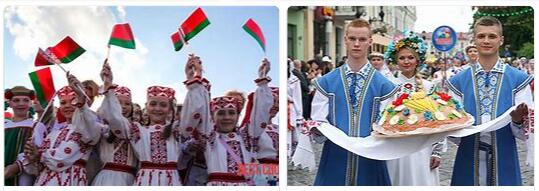Belarus Geography and Society
Belarus is an essentially flat country. Its highest point is Mount Dzyarzhynskaya, 356 m high. We can distinguish three different regions, one to the north, where the lakes of glacial origin are found, another in the center, where there is a wide plateau covered with forests, and another to the south, swampy and practically uninhabited; they are the swamps of Pripyat.
The plateau is made up of a series of parallel bands oriented from west-southwest to east-northwest.
Due to its low altitude, the territory is very poorly drained, so shallow lakes and swamps are very abundant. There are more than 4,000 lakes, but all of them small. The rivers are long, slow and mighty, many of them allow navigation. There are three main rivers that drain Belarus, the Dnieper, the Pripyat and the Niemen.
Relief
It is characterized by being a low plain, with high and undulating lands that rarely exceed 300 m in height.
Hydrography
The Dnieper River runs through the east of the country. It is one of the main rivers in eastern Europe. It has a length of 2,290 km between its source in the Valdai plateau and its mouth in the Black Sea. In Belarus, 690 km of its route pass.
The Prípiat River runs through the south of the country. It is 710 km long, of which 495 km correspond to Belarus. It is born in Ukraine and empties into the Dnieper river near Chernobyl (Ukraine). There is a channel that connects this river as the Bug River, a tributary of the Vistula, passing through the cities of Pinsk and Brest.
The Niemen River is located in the northwest of the country. It is 937 km long, of which 459 km correspond to Belarus. It is born near Slomin, in Godno, from the union of several tributaries, and becomes navigable. It empties into the Baltic Sea, making the border between Lithuania and Kaliningrad.
Other important rivers are the Daugava, the Sozh, the Berezina, the Neris, the Pitichi, the Chara and the Sviloch.
Lakes
The main lakes are: the Narach, of 79.6 km², the Osveya, of 52.8 km² and the Chervono, of 40.3 km², in addition to many other smaller ones.
Climate
The dominant climate is the humid continental climate, which is an extension of the maritime climate of the west coast typical of Western Europe but drier and with more contrasting temperatures, colder in winter and warmer in summer. The thermal oscillation is around 30 ºC. The centers of action that affect the region are the polar front, which brings maritime polar air masses, and which arrive sparingly and in summer, the Siberian anticyclone, which dominates in winter together with other occasional local anticyclones, and the anticyclone of the Azores that occasionally arrives in summer. Summers are hot and rainy, but short, winters are long, cold and dry, with precipitations in the form of snow, especially in autumn. and winter.
Average temperatures range from -6ºC in January to 20ºC in July. The precipitations oscillate between the 700 mm of the west and the 550 mm of the east.
In Belarus there is a clear contrast between the western and eastern regions of the country. The west receives the moderating action of the sea to a greater extent, so the temperatures are less extreme and the rainfall more abundant.
Vegetation
Belarus is a heavily forested country. One third of the country is covered in unpopulated forests. Conifers are the dominant species to the north, while birches and alders appear in the south. In the east the forest gives way to a wooded steppe. Being a very flat country, it is very poorly drained, so swamps and peatlands are frequent, such as the one around the Prípiat River.
Two ecoregions are distinguished: the mixed sarmatic forest, to the north, and the mixed forest of central Europe in the south.
Environmental issues
Belarus has large areas heavily contaminated by radiation after the Chernobyl accident. [1] in 1986
Fauna
Forests occupy 30% of the surface: pine, fir and birch predominate in the north and oak, elm and white beech are predominant in the south.
Flora
The fauna is varied in the country including moose, reindeer, wild boar, wolves, foxes, squirrels, martens, wild hares, beavers, otters, minks, badgers, the European bison that is in serious danger of extinction.
Language
According to andyeducation, the official languages are Belarusian and Russian.
Social development
Demography
Russians are the largest minority, with 13.5% of the population. Other minorities are: Ukrainians, Jews, Poles and Lithuanians. Life expectancy at birth is 76.4 years for women and 64.6 years for men. Infant mortality and other health-related statistics have been generally favorable, although radioactive fallout from the nuclear accident in the Ukrainian city of Chernobyl in 1986 has highlighted Belarus’s good health statistics.
Transport
Belarus has an extensive highway and rail system, and through its navigable rivers and the Dnieper-Bug canal system, it has access to the Baltic Sea and the Black Sea.





